Lifesaving Center
Philosophy and Basic Policy of the Emergency Medical Center
Philosophy
We practice high-quality emergency and acute medical care in collaboration with the local community at our Emergency Comprehensive Medical Center.
Basic Policy
We provide acute medical care that meets diverse medical needs
We will work to enhance the acute phase and emergency medical care system in cooperation with the community.
We operate an ER (emergency outpatient department) that accepts emergency patients with various degrees of illness.
24-hour emergency medical care for critically ill patients
Acting as the core of pediatric emergency medical care
We support wide-area transport of severely ill patients using doctor cars/helicopters both in normal times and in times of disaster.
We will develop human resources who will be responsible for emergency comprehensive medical care.
We will act as a medical support team to respond to prompt patient acceptance in the event of a disaster.
Emergency medical institutions in Japan are roughly divided into primary, secondary, and tertiary.
Primary (primary) emergency medical care facilities refer to facilities that mainly treat emergency patients who do not require hospitalization, such as clinics on holidays and at night, and a home doctor system where doctors from the medical association take turns in charge.
Secondary emergency medical facilities are general emergency hospitals, and there are about 4,000 emergency hospitals nationwide.In order not to place a burden on specific hospitals, there is also a system called a hospital group rotation system in which hospitals in the area take turns accommodating emergency patients depending on the day.
A tertiary care facility is a medical institution that accommodates critically ill patients who are unmanageable at primary and secondary emergency care facilities, or who are judged to be particularly critically ill by paramedics at the scene of an emergency. It is a thing.
This critical care center is not something that each hospital arbitrarily comes forward, but the government (Ministry of Health, Labor and Welfare) designates hospitals that meet specific requirements.The primary, secondary, and tertiary systems in emergency medical care were introduced in 52. Initially, the plan was to have one emergency and emergency center per million population (approximately 100 centers nationwide). As a result, there are currently 130 locations nationwide.
At our hospital, the total number of primary, secondary and tertiary emergency patients reaches 38,000 annually, making it one of the hospitals with the highest number of emergency patients nationwide.Critically ill patients treated at the Critical Care Center include cardiopulmonary arrest due to various causes, acute myocardial infarction, subarachnoid hemorrhage, cerebral infarction, cerebrovascular disorders such as cerebral hemorrhage, multiple traumas that cause many severe injuries to the whole body, whole body Burns, acute poisoning from poisons, etc. fall into this category, and about 1,000 people are admitted to the Emergency and Critical Care Center each year (about a few people each day).
In this way, the emergency medical center is obliged to give instructions and advice to emergency life-saving technicians who are dispatched to the scene, and to be in charge of their training, in addition to treating the most serious emergency patients in regional medical care. We are working together to improve pre-hospital medical care.
The Emergency and Critical Care Center of our hospital is divided into an emergency outpatient department and a critical care unit.The emergency outpatient department is in charge not only of patients with severe tertiary emergencies, but also of secondary emergencies for the citizens of this area on a 24-hour basis. It's the same style as the so-called emergency room (ER) made famous on NHK TV.After being admitted to the Serious Injury Treatment Unit, doctors from cardiology, neurosurgery, and other specialized clinical departments are in charge of treatment.



FY2022 results
ドクターカー活動実績(2021年度実績)
* Side-scrolling is possible
| Fire | ||||||||||||
|---|---|---|---|---|---|---|---|---|---|---|---|---|
| Tsukuba | Tsuchiura | Joso | Handle | southwest | Chikusei | Ishioka | Inashiki | Kasumigaura | Unknown | Total | ||
| diagnostic group | Trauma | 22 | 5 | 2 | 1 | 11 | 3 | 3 | 47 | |||
| Cerebrovascular disease | 11 | 1 | 3 | 2 | 1 | 18 | ||||||
| Acute coronary syndrome | 8 | 1 | 4 | 4 | 17 | |||||||
| Heart disease | 8 | 3 | 1 | 4 | 16 | |||||||
| cranial nervous system disease | 7 | 1 | 1 | 1 | 2 | 12 | ||||||
| Pediatric diseases including febrile convulsions | 5 | 1 | 1 | 2 | 9 | |||||||
| Vascular disease | 4 | 1 | 1 | 1 | 8 | |||||||
| Digestive disease | 2 | 1 | 1 | 1 | 1 | 6 | ||||||
| Anaphylaxis | 2 | 1 | 1 | 1 | 5 | |||||||
| Respiratory disease | 2 | 1 | 2 | 5 | ||||||||
| Others | 62 | 4 | 2 | 9 | 3 | 2 | 2 | 99 | ||||
| Total | 140 | 16 | 18 | 4 | 38 | 15 | 0 | 8 | 3 | 0 | 242 | |
ドクターヘリおよび防災ヘリ運用実績
* Side-scrolling is possible
| 疾病分類 | number |
|---|---|
| Trauma | 18 |
| cranial nervous system | 12 |
| 心臓血管系 | 11 |
| special | 6 |
| Digestive system | 2 |
| Others | 5 |
| Total | 54 |
| 搬送元 | number |
|---|---|
| 北総DH(茨城県から) | 18 |
| Ibaraki DH | 12 |
| 茨城防災ヘリ(当院から) | 11 |
| Others | 5 |
| Total | 54 |
| 茨城防災ヘリ出動 | 3 |
* What is Doctor Helicopter?
A small helicopter loaded with medical equipment and medicines is equipped with emergency medical specialists and nurses.
Our hospital has a heliport and accepts emergency patients by doctor helicopter.
Number of ambulance transports
* Side-scrolling is possible
| April | May | June | July | August | September | 10 | 11 | 12 | January | February | March | Total | |
|---|---|---|---|---|---|---|---|---|---|---|---|---|---|
| Mild | 167 | 213 | 209 | 289 | 218 | 213 | 201 | 205 | 264 | 229 | 196 | 188 | 2,592 |
| moderate illness | 72 | 72 | 67 | 82 | 97 | 74 | 78 | 81 | 97 | 77 | 69 | 82 | 948 |
| Severe | 115 | 107 | 104 | 118 | 99 | 101 | 120 | 108 | 125 | 116 | 102 | 94 | 1,309 |
| Death | 16 | 8 | 10 | 9 | 8 | 11 | 13 | 13 | 16 | 14 | 18 | 13 | 149 |
| meter | 370 | 400 | 390 | 498 | 422 | 399 | 412 | 407 | 502 | 436 | 385 | 377 | 4,998 |
Breakdown of patients who were admitted to the critical care center from the emergency department
* Side-scrolling is possible
| ICU (XNUMXA) | Death | HCU (XNUMXC) | Death | ||
|---|---|---|---|---|---|
| disease | Cardiovascular disease | 258 | 25 | 264 | 21 |
| [Of which, ischemic heart disease] | 【150】 | 【11】 | 【56】 | 【0】 | |
| central nervous system disease | 106 | 17 | 179 | 15 | |
| [Of which, cerebrovascular disease] | 【91】 | 【14】 | 【149】 | 【15】 | |
| Respiratory system | 37 | 5 | 67 | 14 | |
| Digestive system | 23 | 4 | 95 | 6 | |
| Others | 112 | 13 | 161 | 22 | |
| External cause | Trauma | 71 | 9 | 244 | 3 |
| [Of which, multiple injuries] | 【29】 | 【3】 | 【28】 | 【1】 | |
| Acute poisoning | 14 | 0 | 70 | 1 | |
| Total | 621 | 73 | 1,080 | 82 | |







